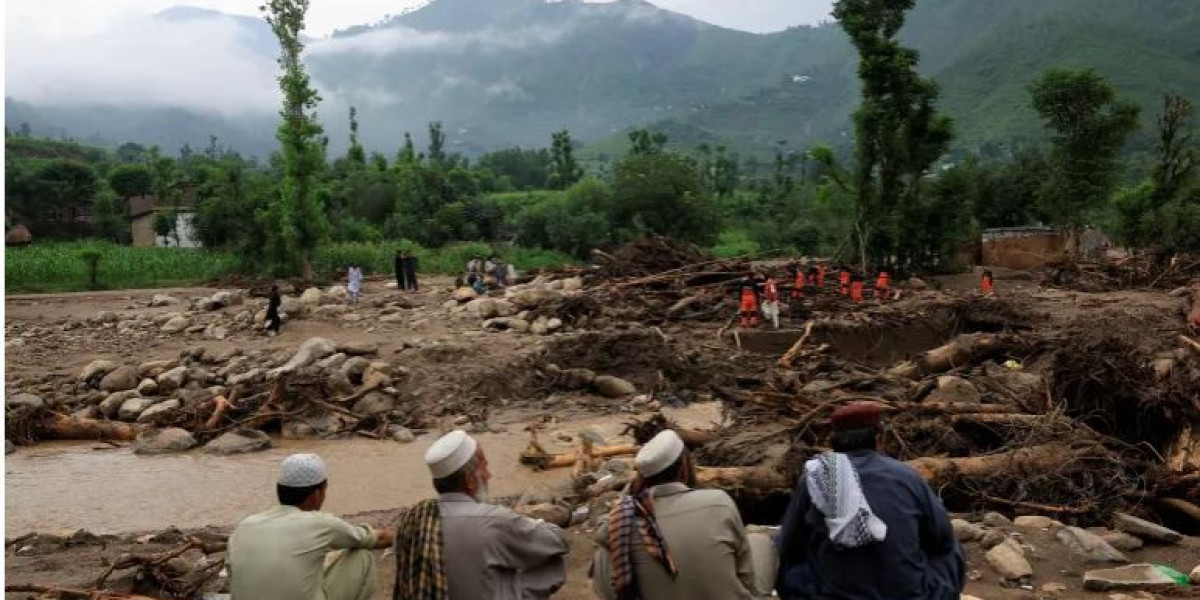A Nation Reeling From Devastation
At least 337 people have been killed and dozens remain missing in northwestern Pakistan, after torrential rains, flash floods, and sudden cloudbursts devastated rural communities over the weekend. The country’s National Disaster Management Authority (NDMA) confirmed the rising death toll, calling the disaster one of the worst in recent years.
Emergency teams are continuing rescue efforts in hard-to-reach areas, including the remote village of Chositi in Kishtwar district, where at least 60 people died and nearly 150 were injured, many of them critically.
“Survivors escaped with nothing. If people had been informed earlier, lives could have been saved,” said Mohammad Iqbal, a schoolteacher in Pir Baba village.
Human Tragedy in Villages
The mountainous Buner district in Khyber Pakhtunkhwa province was among the hardest hit. After hours of search efforts, 54 bodies were recovered, with dozens still unaccounted for. Residents described how massive boulders, carried by flash floods from the mountains, smashed through homes “like explosions.”
The tragedy has struck families in the most personal ways. In Qadar Nagar, mourners recounted how a wedding celebration turned into a funeral after a sudden torrent of mud and water killed 28 relatives gathered in one house.
Government Response and Public Anger
Residents in Buner and other affected districts have accused officials of failing to warn communities in time. In remote regions, mosque loudspeakers are typically used as part of early evacuation alerts — but villagers say no such warnings came before the floods hit.
Officials, however, defended their response:
NDMA chairman Lt. Gen. Inam Haider Malik admitted climate change is shifting Pakistan’s weather patterns, saying rainfall this season is already 50% above last year’s levels.
Provincial Disaster Management Authority director Asfandyar Khan Khattak argued that no system in the world can predict the exact time and location of a cloudburst.
Emergency officials said alerts based on satellite and meteorological data were issued, but the intensity of the sudden downpour overwhelmed response times.
Still, for many survivors, the explanations ring hollow. “If there had been warnings, people would have moved to safer places,” said Iqbal.
Climate Change Intensifying South Asia’s Monsoons
Pakistan has long suffered from monsoon floods, but experts warn that climate change is making extreme weather more frequent and severe. While the country contributes less than 1% of global greenhouse gas emissions, it is among the most climate-vulnerable nations:
Rising glacial melt is fueling flash floods.
Cloudbursts — highly localized, extreme rain events — are striking more often.
Heatwaves and shifting rainfall patterns are destabilizing rural livelihoods.
Neighboring Indian-administered Kashmir has also faced devastation. In one incident, a cloudburst destroyed a makeshift kitchen serving over 100 pilgrims in Chisoti village, killing at least 60. Floods in Kathua district left another seven dead.
International Solidarity
The United Nations Secretary-General António Guterres expressed his condolences, saying he was “deeply saddened by the tragic loss of life” and reaffirmed UN support for Pakistan and India. UN country teams have offered to provide emergency assistance.
However, long-term solutions require more than relief efforts. Analysts emphasize the urgent need for investment in resilient infrastructure, improved forecasting systems, and climate adaptation strategies to prevent future tragedies.
What Lies Ahead
Authorities in Pakistan have warned of more heavy rains and possible landslides in the coming days, urging communities to remain on high alert. Recovery will take weeks, if not months, as roads remain blocked, infrastructure is damaged, and families mourn devastating losses.
For ordinary citizens, frustration is mounting. Pakistan’s repeated monsoon disasters are no longer viewed as “acts of God” but as failures of preparedness, governance, and global climate justice.
Final Thoughts
The catastrophic floods in Pakistan underscore a grim reality: climate change is no longer a distant threat — it is here, and it is deadly. While natural disasters cannot be stopped, lives can be saved with better warning systems, stronger local preparedness, and global support for vulnerable nations.
As survivors in Buner and beyond bury their dead, the world is reminded once again that inaction on climate resilience carries unbearable human costs.















